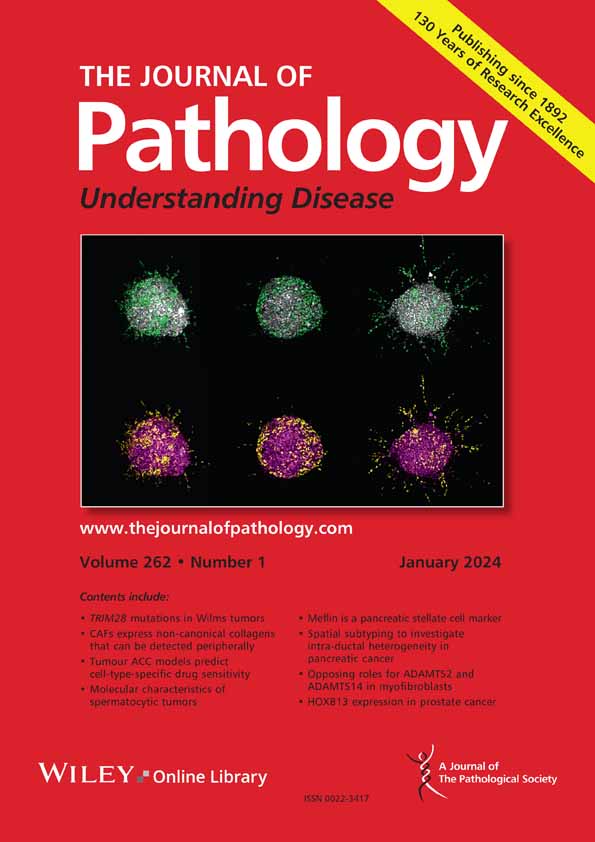Yuedian Ye, Yuanpeng Liao, Yifan Zhang, Jianqiang Zhang, Mayao Luo, Qiao Yang, Qiliang Zhai, Zhuofan Xu, Yutong Wang, Haoran Wen, Chenwei Wu, Yang Qiu, Shidong Lv, Qiang Wei
求助PDF
{"title":"KMT2D缺陷增强了泌尿系统癌症的抗肿瘤免疫并使免疫检查点阻断增敏。","authors":"Yuedian Ye, Yuanpeng Liao, Yifan Zhang, Jianqiang Zhang, Mayao Luo, Qiao Yang, Qiliang Zhai, Zhuofan Xu, Yutong Wang, Haoran Wen, Chenwei Wu, Yang Qiu, Shidong Lv, Qiang Wei","doi":"10.1002/path.6481","DOIUrl":null,"url":null,"abstract":"<p><p>Immune checkpoint blockade (ICB) therapy has made remarkable advances in cancer treatment. However, the overall response rate remains limited. Here, we aim to explore the role of histone 3 lysine 4 mono-methyltransferase KMT2D in tumor immune response and improve the efficacy of ICB. We developed a patient-derived urologic tumor fragment (PDUTF) platform comprising 56 tumors and constructed three major urological tumor tissue microarrays from 356 patients. Analyzed using the PDUTF platform and tissue microarrays (TMAs), we found that tumors with KMT2D deficiency were associated with enhanced T-cell activation in response to anti-PD-1 therapy and exhibited increased T-cell infiltration. Subsequently, T-cell migration and T-cell-mediated tumor cell killing assays revealed that the deletion of KMT2D in cancer cells promoted CD8<sup>+</sup> T-cell migration and cytotoxicity against tumor cells. Mechanistically, the loss of KMT2D enhanced antitumor immunity by promoting chemokine-mediated recruitment of T cells both in vitro and in vivo. Finally, the small-molecule inhibitor MI-503 combined with anti-PD-1 therapy suppressed tumor growth on the PDUTF platform. Collectively, KMT2D deficiency sensitizes tumor cells to ICB, and inhibiting KMT2D may represent a promising approach in combination with ICB to improve patient prognosis. © 2025 The Pathological Society of Great Britain and Ireland.</p>","PeriodicalId":232,"journal":{"name":"The Journal of Pathology","volume":" ","pages":""},"PeriodicalIF":5.2000,"publicationDate":"2025-10-06","publicationTypes":"Journal Article","fieldsOfStudy":null,"isOpenAccess":false,"openAccessPdf":"","citationCount":"0","resultStr":"{\"title\":\"KMT2D deficiency potentiates antitumor immunity and sensitizes immune checkpoint blockade in urologic cancers.\",\"authors\":\"Yuedian Ye, Yuanpeng Liao, Yifan Zhang, Jianqiang Zhang, Mayao Luo, Qiao Yang, Qiliang Zhai, Zhuofan Xu, Yutong Wang, Haoran Wen, Chenwei Wu, Yang Qiu, Shidong Lv, Qiang Wei\",\"doi\":\"10.1002/path.6481\",\"DOIUrl\":null,\"url\":null,\"abstract\":\"<p><p>Immune checkpoint blockade (ICB) therapy has made remarkable advances in cancer treatment. However, the overall response rate remains limited. Here, we aim to explore the role of histone 3 lysine 4 mono-methyltransferase KMT2D in tumor immune response and improve the efficacy of ICB. We developed a patient-derived urologic tumor fragment (PDUTF) platform comprising 56 tumors and constructed three major urological tumor tissue microarrays from 356 patients. Analyzed using the PDUTF platform and tissue microarrays (TMAs), we found that tumors with KMT2D deficiency were associated with enhanced T-cell activation in response to anti-PD-1 therapy and exhibited increased T-cell infiltration. Subsequently, T-cell migration and T-cell-mediated tumor cell killing assays revealed that the deletion of KMT2D in cancer cells promoted CD8<sup>+</sup> T-cell migration and cytotoxicity against tumor cells. Mechanistically, the loss of KMT2D enhanced antitumor immunity by promoting chemokine-mediated recruitment of T cells both in vitro and in vivo. Finally, the small-molecule inhibitor MI-503 combined with anti-PD-1 therapy suppressed tumor growth on the PDUTF platform. Collectively, KMT2D deficiency sensitizes tumor cells to ICB, and inhibiting KMT2D may represent a promising approach in combination with ICB to improve patient prognosis. © 2025 The Pathological Society of Great Britain and Ireland.</p>\",\"PeriodicalId\":232,\"journal\":{\"name\":\"The Journal of Pathology\",\"volume\":\" \",\"pages\":\"\"},\"PeriodicalIF\":5.2000,\"publicationDate\":\"2025-10-06\",\"publicationTypes\":\"Journal Article\",\"fieldsOfStudy\":null,\"isOpenAccess\":false,\"openAccessPdf\":\"\",\"citationCount\":\"0\",\"resultStr\":null,\"platform\":\"Semanticscholar\",\"paperid\":null,\"PeriodicalName\":\"The Journal of Pathology\",\"FirstCategoryId\":\"3\",\"ListUrlMain\":\"https://doi.org/10.1002/path.6481\",\"RegionNum\":2,\"RegionCategory\":\"医学\",\"ArticlePicture\":[],\"TitleCN\":null,\"AbstractTextCN\":null,\"PMCID\":null,\"EPubDate\":\"\",\"PubModel\":\"\",\"JCR\":\"Q1\",\"JCRName\":\"ONCOLOGY\",\"Score\":null,\"Total\":0}","platform":"Semanticscholar","paperid":null,"PeriodicalName":"The Journal of Pathology","FirstCategoryId":"3","ListUrlMain":"https://doi.org/10.1002/path.6481","RegionNum":2,"RegionCategory":"医学","ArticlePicture":[],"TitleCN":null,"AbstractTextCN":null,"PMCID":null,"EPubDate":"","PubModel":"","JCR":"Q1","JCRName":"ONCOLOGY","Score":null,"Total":0}
引用次数: 0
引用
批量引用

 求助内容:
求助内容: 应助结果提醒方式:
应助结果提醒方式:


